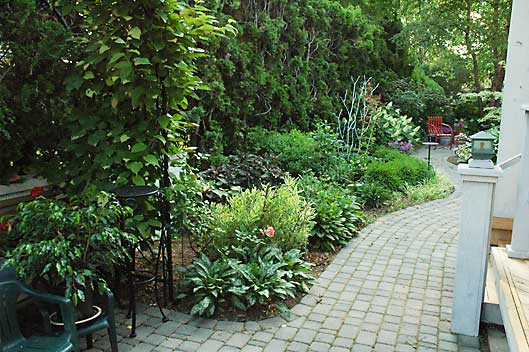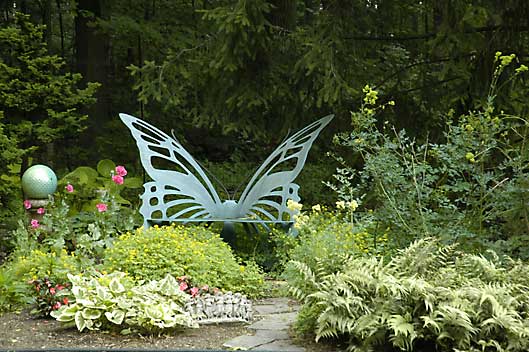Will reseeding plants emerge through mulch?
Will reseeding plants like spider flower (Cleome), Verbena bonariensis, cosmos, and others successfully seed themselves through 2 inches of mulch applied last fall?
Well… yes and no. The three annuals (and might I add, prolific reseeders) that you mentioned are sure to show up again in your garden, however, not necessarily where you wanted them. They won’t actually start sprouting with a good cover of mulch. Assuming that you had mulched with a shredded wood material, the myriad of seedlings cast upon the wind will most likely end up in the cracks of your (and possibly your neighbors) flagstone, and practically any spot where it can reach the bare soil. All three of these annuals can easily be lifted and relocated back into your garden. Then next fall, if you clear a patch of mulch from the soil and shake a few dried seed heads over the soil in the desired garden bed, you’ll more than likely get at least a few in the “right” spot.
Website Extra: Janet’s Journal
 Photos by Steven Nikkila
Photos by Steven Nikkila
Mixed borders require a bit of extra planning and work but can provide four-season interest even in a small space. These gardens combine plants from three or more of the categories: trees, shrubs, dwarf conifers, perennials, bulbs, annuals and biennials. Here in a partly shaded spot, a black spruce tree, dwarf false cypresses, and a bench provide winter interest while perennials such as variegated brunnera (front, center), golden bleeding heart (Corydalis lutea, center, yellow flowers) and painted fern (Athyrium nipponicum ‘Pictum’) cover up bulbs, team with annual begonias and provide interest in other seasons.Mixed borders: A brief history
The term “mixed border” first came into use and such beds began to be planted in the early 1900’s when gardening broke free from large estates where labor-intensive, single season beds filled spaces labeled “Spring border,” “Summer parterre,” and “Fall cutting garden.” More people were gardening on smaller properties where a single area had to have longer interest. Those gardeners wanted a little of everything but with more organization than in the old cottage garden plot. During the world wars, there were few developments. Then during the 1950’s influential writers revived the term and since then some of the best designers in the world have been fine-tuning the mixed border style.
Advantages in a good mix
Those post-war designers were intrigued by the mixed border’s potential for four-season interest, flowers, and structural plants all in a small space.
Historically, herbaceous gardens were four-month wonders dominated by annuals, and could look very sad in the off-season. Adding perennials, some with bloom seasons beginning very early and others that didn’t flower until the very end of fall, stretched that four months of color to eight. Including evergreens and woody plants with fine form could round out the year.
The mixed border style answered other needs too. Woody plants purchased large could provide significant mass, which was an immediate relief and eventual balance between the garden and background buildings or scenery. This helped to satisfy the current age’s urge for instant gratification. Promoting equal use of all plants also meant that nurseries—producers of trees and shrubs—and greenhouse operations could grow together rather than compete. Developing into garden centers and riding a 50-year wave of gardening popularity, these businesses now make it possible to buy almost anything even as they stimulate demand with displays that feature “having it all” in one garden.
 Photos by Steven Nikkila
Photos by Steven Nikkila
Garden center businesses have thrived on the same goals that led to the rise of mixed borders like this: We want it all, now, even in a small space. Here in a long, narrow bed along an arborvitae hedge, variegated kiwi vine, lungwort (Pulmonaria), variegated obedient plant (Physostegia virginiana ‘Variegata’), ‘Chocolate’ Joe pye (Eupatorium maculatum ‘Chocolate’), big betony (Stachys macrantha), boxwood shrubs, red-violet small-flowered clematis on a metal sculpture, and oakleaf hydrangea bushes (H. quercifolia) provide year-round interest.Mixed beds for prolonged interest
“…early and late perennials have to be included when borders are designed for extended interest, but many people prefer to augment sparse displays of these with temporary or permanent plants from other groups—such as annuals, shrubs and bulbs. They then become mixed borders rather than herbaceous borders…”
—From The Complete Book of Gardening, edited by Michael Wright
- « Previous Page
- 1
- …
- 163
- 164
- 165
- 166
- 167
- …
- 285
- Next Page »
